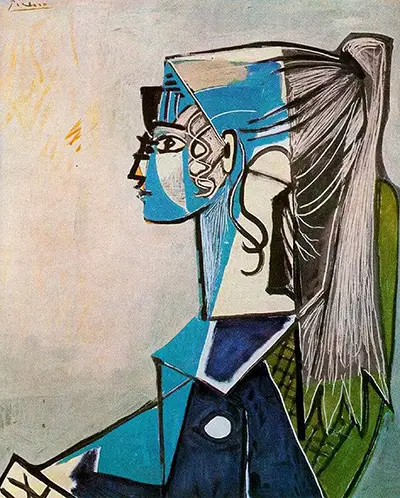It is among a series of over 40 portraits completed over a 3 month period which feature the same muse.
At just 19 years of age, Sylvette David inspired Picasso with her coquettish appearance and intriguing beauty.
He made a particular feature in his work of her characteristic high pony-tail which has become an iconic element of these works.
Surprisingly, this was the first time that Picasso had successfully worked from a model and there is no doubt that she entered his life at a difficult time for the artist.
In the previous year, aged 73, Picasso had been deeply saddened by the end of his marriage to Francoise Gilot with whom he had two children. Shy, modest and youthful, Sylvette was, perhaps, the breath of fresh air that the artist needed at this unsettling time.
It is likely that Picasso first spotted his muse as she walked to meet her boyfriend, a furniture designer whose workshop was close to Picasso’s studio, in the small town of Vallauris in Southern France. However, it was not until Sylvette was drinking coffee with friends outside the pottery studios where she worked that Picasso approached her by holding up a portrait for her to see from his studio opposite.
The image was, of course, a portrait of her, painted from memory. Seeing this act as an invitation, she and her friends went round to Picasso’s studio and this led to Sylvette posing regularly for the artist. However, unlike several of his muses, Sylvette resisted Picasso’s charms and refused to pose nude for him. It was, perhaps, part of her shy resistance towards him that intrigued the artist and only served to compound his desire to immortalise her through works of art.
In this particular portrait, we see the model sitting side on, perhaps to show the distinct look of her high ponytail. In classic Cubist style, the image of Sylvette is broken up and pieced together again in a re-evaluated form. This allows the artist to place focus on particular elements, as shown in the way Picasso exaggerates other of her distinctive features, including her long neck and oval eyes.
Sylvette's mouth is painted small and was, in fact, omitted from several other portraits of her, perhaps to show her reserved character and the fact that she spoke very little. The coat she wears in the portrait is another distinctive feature with its large buttons. It is thought to have been designed by her fiance and features in other portraits of her. This could, perhaps, be another nod to Sylvette's character as 'buttoned up' and reserved, and to the modest sense of dress for which she was known.
Later in the summer of 1954, a series of works featuring the artist's muse were displayed in Paris to a rapturous reception. Those that viewed the exhibition were amazed by the range and versatility of Picasso's work which demonstrated a huge variation in style from detailed, naturalistic portraits to experimental Cubist works such as the one depicted here. This period became known in the media as Picasso's 'Ponytail Period' and Sylvette herself became an icon, even to the likes of a young and, as yet unknown, Brigitte Bardot.
As well as the series of paintings, Picasso also immortalised Sylvette in a number of ceramics and sculptural works. Sculptures include Lady with a Key and the 'Heads of Sylvette' series which features folded and painted metalwork. On a much larger scale, the 'Chicago Picasso', as it is usually known, is also thought to have been inspired by Sylvette.
Sylvette, who now goes by the name of Lydia Corbett, is now an artist in her own right, exhibiting at the Francis Kyle Gallery in London. She has commented that her time spent with Picasso was 'wonderful' and how it changed her life and inspired confidence in her. She has also commented on how grateful she was to Picasso for immortalising her through his work. At the end of their time working together, she presented the artist with a sculpture of her own making as a token of thanks.
One of the greatest legacies of this series of works featuring Sylvette is the way it explores a 3 month progression of work by Picasso using the same muse and experimenting with a wide range of materials, including charcoals, pencil, oils, metal and paper.


